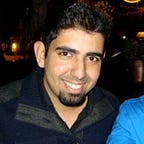It was 5am on Saturday, April 26, when Dr. Pramod Khanal (37) was startled awake with a phone call. “A massive earthquake has hit Nepal”, his uncle told him. Dr. Khanal quickly turned to BBC to get the latest news. A magnitude 7.8 earthquake had rocked Nepal, it’s epicenter halfway between Kathmandu and Pokhara. Thousands of people lost their lives, and millions more were affected.
“I panicked,” he said. “I tried to call my parents in Kathmandu, but I couldn’t get through. The network was busy.”
Dr. Khanal was in Denver preparing for the US MLE license exam, which will allow him to practice medicine in the United States. “I’m a medical professional, but I felt helpless. It was then that I knew that I had to come back to Nepal to help my people.”
Dr. Khanal knew from his previous work experience at the WHO that he could have a bigger impact if he traveled with a team.
He left no stone unturned in his search to find a medical team headed for Nepal. He reached out to the Nepali American Physician’s Association, and various Nepali student groups on Facebook. Eventually, a mutual friend connected him to Dr. Fahim Rahim, MD FASN.
In Idaho, Dr. Rahim, was organizing the largest private American earthquake relief effort in Nepal. Dr. Khanal joined Dr. Rahim’s earthquake relief team with the JRM Foundation, and immediately left for Nepal.
“I was in Kathmandu in less than 24 hours after that phone call with Dr. Rahim,” Dr. Khanal said.
In Nepal, Dr. Khanal teamed up with 5 other doctors from the Dhulikhel Hospital and decided to go to the remote villages in the Sindupalchowk District.
Normally, they could have chartered a helicopter and flown directly to the villages, but the Nepal Army had summoned all helicopters for relief and rescue missions. That didn’t deter them. They drove as far as the road went in Melamchi, a town on the foothills in Sindupalchowk District, and set off on foot.
They loaded their backpacks with more than 20kgs of water, food and medical supplies, and started trudging along on the grueling 9 hour hike up to Manekharka Village.
“In those 9 hours, I didn’t see one house that was habitable. All are blasted,” he said.
They saw landslides and flattened villages, juxtaposed with beautiful terrace farms and snow-capped Himalayan mountains.
Villages and towns across Sindupalchowk District were badly damaged in the M7.8 earthquake on Saturday, April 25th, and then a M6.7 aftershock the following day completely flattened whatever remained.
Dr. Khanal and his team stopped by villages Tipeni and Dhap, along the way and administered first-aid.
They eventually reached Manekharka village, where the local medical team was already working around the clock treating injuries, infections, and broken bones in an open field. They replenished the Health Clinic with supplies, and started treating patients as well.
They even successfully requested a helicopter evacuation for 3 patients that immediately needed surgery and intensive care.
They walked to several other villages too.
In Chilaune, Dr. Khanal went door to door to severely damaged houses to check up on families and deliver first aid.
In Bolgaun village, survivors started taking him to the houses that needed the most medical care.
Even though, it had been several days since the earthquake, Dr. Khanal and his team were the first responders in every village they went to.
Two days later, they hiked 9 more hours towards the Helambu region, where they were picked up and driven back to Dhulikhel Hospital.
Despite walking for miles through difficult terrain, sleeping in a tent without a mattress, and working around the clock, Dr. Khanal didn’t take a break. Shortly after arriving at Dhulikhel Hospital, he drove over to JRM Foundation’s Health Clinic in Lalitpur.
When asked about the upcoming monsoon season, Dr. Khanal looked concerned. “People have lost their homes and existing water systems are damaged. We will need to mobilize all possible medical professionals into the hardest hit areas, like Sindupalchowk, Gorkha and Rasuwa, to raise awareness about hygiene and sanitation, and give preventative medicines against communicable infectious diseases.”
The problem is, the villagers don’t have materials to build new homes, so they’re building shelters out of the rubble. “When monsoon starts, and they still don’t have toilets and proper sanitation available. The chances of the local water supply becoming contaminated is high, which will result in an outbreak.”
While talking about his next steps in Nepal, Dr. Khanal added, “Students are in traumatic shock after this earthquake. We need to make sure they have proper counseling available in schools.”
On Facebook, Dr. Rahim said: “This man is my hero. Team member of JRM Foundation from Denver, Dr. Pramod Khanal. He has been deployed to Manekhara deep in Sindupalchowk. He walked to get there, with little water and supplies for himself.”
Dr. Khanal always had a smile on his face, and treated his patients with great care and empathy.
The JRM Foundation is led by Dr. Rahim who is more than 10% along his way to reaching his goal of raising One Million Dollars for Nepal’s earthquake relief and recovery effort.
You can support Dr. Khanal, Dr. Rahim and the JRM Foundation by donating to their online campaign for earthquake relief on the CrowdRise crowdfunding platform.
If you enjoyed reading this article, you should follow me on Twitter at @amrit_sharma
Special thanks to Becky L Duncan for her suggestions and edits to this post.
